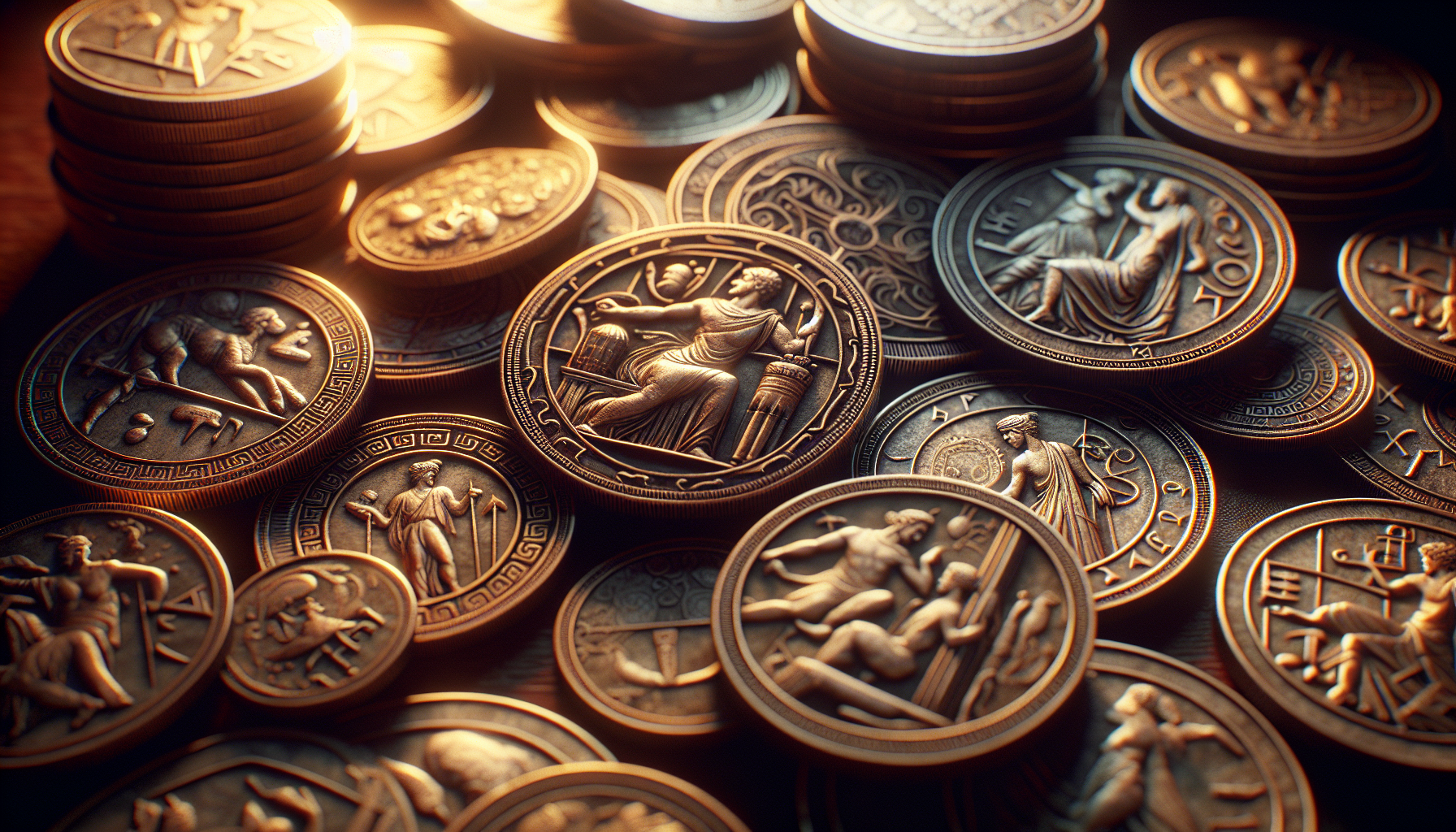What is a Drachma?
The drachma is an ancient Greek currency that dates back to the mid-6th century BC. It was a silver coin that became the foremost currency in the Greek world, particularly in Athens, during the 5th century BC. The name “drachma” comes from the Greek verb meaning “to grasp,” and its original value was equivalent to that of a handful of arrows.
The drachma was not only a currency but also a symbol of Greek aesthetics, craftsmanship, and commercial power. It served as an international currency in Europe and Asia, influencing the design of other coins, such as the Islamic dirham. The study of coins, known as numismatics, is intertwined with historical events and provides insights into the economic and cultural significance of the drachma.
Definition and Etymology of Drachma
The word “drachma” is derived from the Greek word “drax,” which means “a handful.” In ancient Greece, a drachma represented the amount of silver that could be held in one hand, typically equivalent to six obol coins. This etymology reflects the practical nature of the currency and its connection to everyday transactions.
The drachma was primarily minted in silver, although some bronze coins were produced in the 4th century BC. Gold drachmas were rare and held a higher value. The standard weight of a drachma coin was approximately 4.3 grams, making it a convenient size for trade and commerce.
Drachma as Ancient Greek Currency
The drachma became the dominant currency in ancient Greece, particularly in Athens, during the 5th century BC. It was used for a wide range of transactions, from daily purchases to large-scale trade deals. The Athenian drachma, known for its high silver content and consistent weight, became a standard currency throughout the Greek world.
The value of the drachma was based on a system of units, with 1 drachma equaling 6 oboli, 100 drachmas equaling 1 mine, and 60 mine equaling 1 Attic talent. This standardized system facilitated trade and financial transactions across different city-states and regions.
History of the Drachma
The history of the drachma spans several centuries, from its origins in ancient Greece to its reintroduction in the modern era. Throughout its existence, the drachma underwent various changes in design, value, and usage. Understanding the timeline of the drachma provides insights into the economic and political developments of ancient Greece and its influence on the broader Mediterranean world.
The drachma’s longevity and stability as a currency are notable, especially when compared to other historical currencies. For example, the Byzantine solidus maintained its value for seven centuries, while the Arab dinar and the Spanish silver dollar each held their value for four centuries. The drachma’s six-century span as a dominant currency demonstrates its significance in the ancient world.
Origin and Early Usage of Drachma
The drachma originated in Lydia, a region in Asia Minor, around 550 BC. It quickly spread to other parts of the Greek world, with mints established in cities such as Aegina, Athens, Corinth, and Siphnos. These early drachma coins were made of silver and featured various designs and symbols specific to each city-state.
The Aeginetic drachma, minted in the island of Aegina, was one of the earliest and most widely used versions of the coin. It had a distinctive design featuring a sea turtle, which became a recognizable symbol of Aeginetic currency. The Athenian drachma, with its iconic owl design, emerged as a dominant currency in the 5th century BC.
Drachma in Classical and Hellenistic Periods
During the Classical period (5th-4th centuries BC), the Athenian drachma gained prominence as Athens became a major commercial and cultural center. The standardized weight and high silver content of the Athenian drachma made it a reliable and trusted currency throughout the Greek world.
The conquests of Alexander the Great in the late 4th century BC led to the spread of the drachma across the Hellenistic world. The drachma became the primary currency in the vast territories controlled by Alexander and his successors, from Greece to India. This expansion further solidified the drachma’s status as an international currency.
Drachma in the Modern Era
The drachma disappeared from circulation for several centuries after the Roman conquest of Greece. However, it was reintroduced as the official currency of the modern Greek state in 1832, following the country’s independence from the Ottoman Empire. The modern drachma was initially pegged to the French franc and featured the portrait of King Otto, the first king of modern Greece.
Throughout the 19th and 20th centuries, the drachma underwent several reforms and revaluations. In 2001, Greece joined the European Union’s single currency system, and the drachma was officially replaced by the euro in 2002. The transition to the euro marked the end of the drachma’s long history as Greece’s national currency.
Denominations and Subdivisions of the Drachma
The ancient Greek drachma was not only a single coin but also a unit of currency with various denominations and subdivisions. These smaller and larger denominations allowed for a wide range of transactions and financial exchanges. Understanding the different denominations and subdivisions of the drachma provides insight into the monetary system of ancient Greece.
The denominations and subdivisions of the drachma were based on a sexagesimal system, which means that the units were divisible by six. This system likely originated from the use of six spits or obeloi, which were small metal rods used as currency before the introduction of coins.
Drachma Subdivisions: Obolus and Chalkos
The primary subdivision of the drachma was the obolus (plural: oboli). One drachma was equivalent to six oboli. The obolus was a small silver coin that was commonly used for everyday transactions, such as buying food or paying for services.
The obolus itself had a smaller subdivision called the chalkos (plural: chalkoi). The chalkos was a bronze coin, and eight chalkoi were equal to one obolus. The chalkos was used for even smaller transactions and was particularly useful for those with limited means.
| Unit | Value | Metal |
|---|---|---|
| Drachma | 1 drachma | Silver |
| Obolus | 1/6 drachma | Silver |
| Chalkos | 1/48 drachma | Bronze |
Drachma Multiples: Didrachma to Decadrachma
In addition to the standard drachma coin, there were also multiples of the drachma used for larger transactions. The most common multiples were the didrachma (2 drachmas), tetradrachma (4 drachmas), and decadrachma (10 drachmas). These larger denominations were particularly useful for trade and high-value exchanges.
The tetradrachma, also known as the stater, was one of the most widely used coins in ancient Greece. It had a value of four drachmas and was often used for international trade and large purchases. The decadrachma, with its value of ten drachmas, was a less common but still significant denomination.
- Didrachma: A silver coin worth 2 drachmas.
- Tetradrachma (Stater): A silver coin worth 4 drachmas, widely used for trade.
- Decadrachma: A large silver coin worth 10 drachmas, used for high-value transactions.
- Golden Stater: A rare gold coin worth either 2 gold drachmas or 20 silver drachmas.
Design and Iconography of Drachma Coins
The design and iconography of drachma coins varied across different city-states and time periods in ancient Greece. Each city-state had its own distinctive symbols, deities, and motifs that were featured on their coins. These designs not only served as a means of identification but also reflected the cultural, religious, and political values of the issuing authority.
The artwork and craftsmanship of drachma coins were of high quality, with intricate details and refined techniques. The coins were typically struck by hand, using a hammer and anvil, which required great skill and precision. The beauty and artistry of drachma coins contributed to their popularity and value as a medium of exchange.
Athenian Drachma Design
The Athenian drachma, one of the most recognizable and influential coins in ancient Greece, had a distinctive design featuring the goddess Athena on the obverse (front) and an owl on the reverse (back). Athena, the patron goddess of Athens, was depicted wearing a helmet, symbolizing her role as a warrior and protector of the city.
On the reverse, the owl, often accompanied by an olive branch, was a symbol of Athena’s wisdom and the city’s prosperity. The owl design became so closely associated with Athens that the phrase “bringing owls to Athens” was used to describe a pointless or redundant action, as Athens was already abundant with owls.
Designs on Drachmas from Other City-States
Other city-states in ancient Greece had their own unique designs on their drachma coins. For example, the drachmas of Corinth featured the mythical winged horse Pegasus on the obverse and the helmeted head of Athena on the reverse. The city of Thebes had a distinctive shield design on their coins, while the island of Rhodes featured the sun god Helios.
The Kingdom of Macedonia, under the rule of Philip II and later Alexander the Great, issued drachmas with the head of Heracles (Hercules) wearing a lion’s skin on the obverse and Zeus seated on a throne on the reverse. These designs were meant to associate the Macedonian kings with the strength and power of these legendary figures.
| City-State | Obverse Design | Reverse Design |
|---|---|---|
| Athens | Goddess Athena wearing a helmet | Owl with olive branch |
| Corinth | Pegasus (winged horse) | Helmeted head of Athena |
| Thebes | Boeotian shield | Various designs |
| Rhodes | Head of the sun god Helios | Rose (rhodon) or Athena |
| Macedonia (Philip II) | Head of Heracles wearing lion skin | Zeus seated on a throne |
Cultural and Economic Significance of the Drachma
The drachma held immense cultural and economic significance in ancient Greece and beyond. It was not merely a means of exchange but also a symbol of Greek identity, wealth, and power. The widespread use of the drachma facilitated trade, fostered cultural exchange, and contributed to the prosperity of the Greek world.
The drachma’s influence extended beyond the borders of ancient Greece. It served as an international currency, being accepted and traded in distant lands. The stability and reliability of the drachma, particularly the Athenian drachma, made it a preferred currency for merchants and traders across the Mediterranean region.
Drachma in Literature and Mythology
The drachma is mentioned in various works of Greek literature and mythology, attesting to its cultural significance. In the New Testament, the parable of the lost drachma (Luke 15:8-10) uses the coin as a metaphor for something precious that is lost and then found, emphasizing its value.
In Greek mythology, coins, including the drachma, were often associated with the underworld and the passage of souls. The custom of placing a coin in the mouth of the deceased, known as “Charon’s obol,” was believed to pay for the ferry ride across the river Styx to the realm of the dead.
Drachma as an International Trade Currency
The drachma played a crucial role in facilitating international trade in the ancient world. The standardized weight and high silver content of the Athenian drachma, in particular, made it a trusted and widely accepted currency. Merchants and traders from different regions and cultures used the drachma as a common medium of exchange, fostering economic integration and growth.
The widespread use of the drachma also facilitated cultural exchange and the spread of Greek ideas, art, and philosophy. As Greek traders and colonists ventured to distant lands, they brought with them not only their coins but also their customs, beliefs, and knowledge. The drachma, therefore, served as a bridge between cultures and civilizations.
See also:

